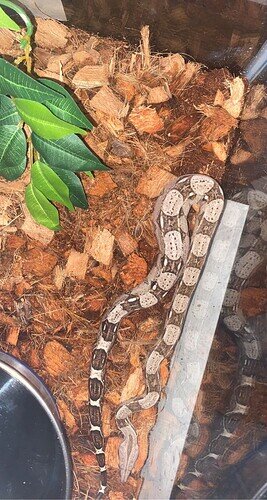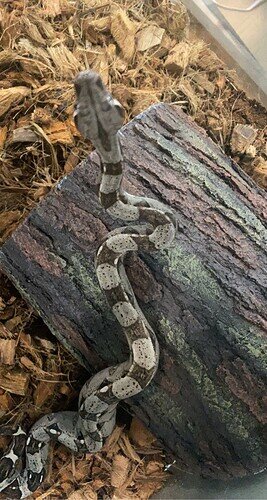Try to let your images fully load
Ok ima try again
That’s a standard Colombian BCI.
In the past “Red Tail Boa” was often used for common Colombian BCI boas. “True Red Tail Boas” was often used for BCC. So if it was sold to you as a “red tail” it could really be either, but it is obviously not BCC.
Thanks just was making sure because I’ve read they husbandry is a little different
100% normal BCI. Your is a beautiful BCI btw. 
I would say BCI because of over all color and tail colors. It could be a BCI X BCC as it has 19 saddles to the vent. That count falls in the BCC category. With all the cross breeding going on for over 20 years its hard to find a pure locality boa now. So if you want a pure locality boa you need to find a good breeder who deals with pure localitys. There are a few still around and some are on this site.
Pure locality has definitely been my focus as far as breeding. If I could I’d breed all kinds though. So many great looking boas, so little square footage:rofl:
Hey! I was reading your comment about the saddles on this post, and was wondering if that’s a way to identify if there’s been any cross breeding between bcc/bci? I’m new to this, I have 6 boas, but they’re all babies. Also was wondering if you might be able to identify what morphs are in a set of baby boas I recently came into if I sent you pics?
I just made a post about Scale counts for boas.
Post some pictures of your boas there and me and some of the others here will try and help you out best we can.
I think we may have purchased sibling “Columbian Redtail’s “. I also purchased some alleged Colombian true red tails. these animals were born on February 13, 2022. They are absolutely gorgeous. however, one of my friends mentioned that they didn’t look quite like your typical BCI and he noted the saddle count on mine as well as it only has 19 or 18. Also, the dorsal scale count was 82 for mine. I did not do the ventral counts. I will have to do it the next shed. I’ve been doing research and there are in fact, true Colombian BCC‘s, but not many make it to market so the assumption is always any Colombian is a BCI. One of my friends asked me about it because he said the head on my snake well it didn’t look truly the shape of your typical bcc. It didn’t look as chunky as a BCI and neither does yours, which makes me wonder as I look at it, are they siblings and if we are wondering the same thing. Beautiful snakes either way. A second and more probable supposition is that these are true Columbian BCI‘s meaning pure Columbian without any Central America blood in it. I’m starting to think that is in fact the case and in the research I’ve done and after speaking with a veterinarian who specializes in reptiles, I’ve learned that there is a lot of speculation that true Colombian BCI‘s, and Venezuelan BCI may in fact be more aligned with BCC as both countries, have BCC populations, and BCI of each have very strong BCC characteristics and traits, so there’s likely been lmited natural mixing over the millennia. He also pointed out to me that unlike central, American boss, Colombian, BCI, and to some extent Venezuela as well grow significantly larger than central American BCI’s, and their final sizes on more line with the BCC. The parents of this batch have been described as a male over 7 feet in a female of 11 feet. Even if exaggerated somewhat, those are still on the larger end of both BCI and bcc. So again, it makes me wonder.
I’m curious, those pics looks identical to my Colombian and they were born on the same day, what city did you buy it from?








